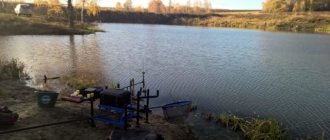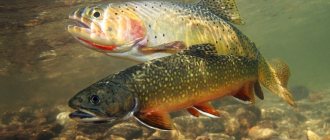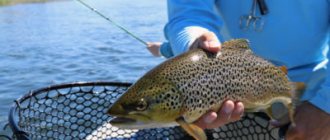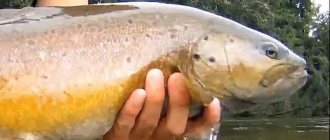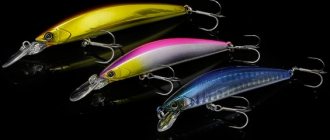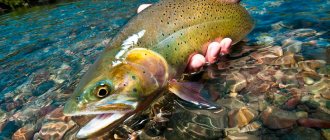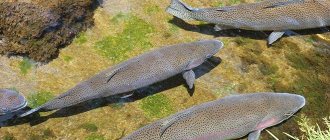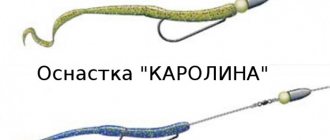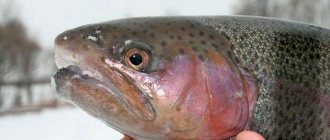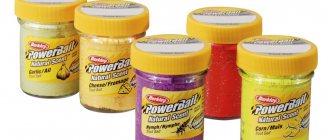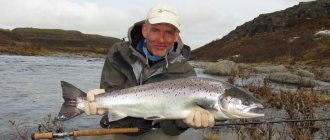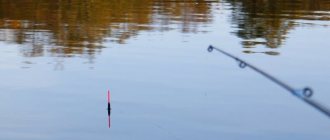I became acquainted with trout and the local Fishing Festival at Shawinigan River. There I learned how to troll trout during the summer months. But here's to getting to holiday directly in Montreal I only succeeded this year. There I looked at various equipment options for fishing Quebec trout.
about spinners for trout fishing , which you can buy here. Small spoons, spinners, small wobblers - over several years they were tested on the Shawinigan River and showed good results there.
But there is a current on the river, but in places where trout are caught during the Fishing Festival, there is usually no current, so the variety of equipment used is much wider. Below I will describe various trout fishing options that can be used both during the holidays in Montreal and on other bodies of water in Quebec.
1. Bottom equipment for standing water.
The main line passes through a sliding sinker (olive, bullet, drop, cylindrical), then through a small bead and tied to a swivel or snap hook. The bead prevents the knot from being broken by the weight when casting. In extreme cases, you can do without a bead, because the weights are used with small weights.
A leash from 15 to 30 cm with one small hook is tied to a swivel or carabiner. Hooks with a long shank are more convenient for attaching worms, while those with a short shank are more convenient for artificial eggs and corn.
This is the simplest equipment for standing water (ponds, lakes). Small weights are used, from 14 to 28 grams, since rods and lines for trout fishing weighing 200-450 grams are used with small weights. If there are branches, algae, a scattering of stones at the bottom of the reservoir, then the bullet, like a weight, passes through it all better.
The usual bait is earthworms. You can also plant artificial salmon eggs (1-2 eggs each) and canned corn (2-3 corn eggs each). For donkey, artificial eggs should not be too soft, as the trout will quickly tear them off. Bright orange eggs work well. Worms are traditionally an excellent bait; trout actively swallow them and can fiddle with the bait for a long time without throwing it.
2. Bottom equipment for current.
If you use sliding drop weights or weights with a cylindrical shape in the current, they will roll along the bottom. Therefore, dead hooks on branches and stones are inevitable, which means that the gear will break. To avoid this, it is best to use flattened sliding weights or make equipment according to the patternoster principle. Otherwise, the baits and leaders are the same as for bottom equipment for calm water.
3. Bottom equipment for floating baits.
The weights here are the same as in the rigs described above. Here, only a longer leash is used, from 30 to 90 cm. The paste that is sold in stores is floating, it is not very suitable for float fishing, since the hook with the paste floats above the weights and the level of the bait in the water layer is difficult to control.
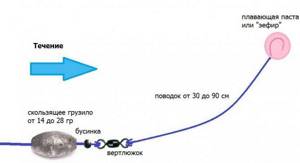
For floating paste, from which a ball is simply molded, it is best to use a tee rather than a single hook. The paste will stick better, more evenly, and when a fish bites, the chance of catching it is higher. If you use floating eggs, you can plant them one, two, or three on a tee.
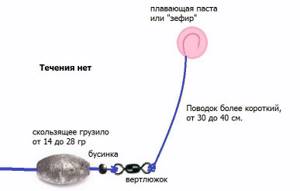
If it is necessary to make floating worms, then air is pumped into the worms already attached to the hook with a small syringe with a needle. This causes the worms to hang in the water column rather than being located at the bottom of the reservoir.
4. Equipment for active wiring.
This equipment is used both in still water and in currents. A hook is attached to the main line. Several clamping weights-pellets are fixed 30-40 cm from the hook. The tackle is cast, a short pause is made so that the sinkers and the bait sink to the bottom, then they are dragged in by making a couple of turns with the reel.

Very similar to the stepped retrieve when fishing with a jig. If there is a strong current in the fishing area, the tackle will “hang” in the water column. In small currents or in still water, the pellet weights will be the first to fall to the bottom, and then the bait (corns, worms, silicone) will slowly fall to the bottom. It is at this moment that the trout most often takes it.
5. Oscillating spoon with a leash.
This is a traditional rig for Quebec and is used to catch both rivers and lakes. To do this, take different oscillating spoons (5-10 cm), tie a 30-cm leash with one small hook instead of tees. Worms (live or silicone) and artificial salmon eggs are used as baits.
The spoon itself is used, firstly, as a sinker - to throw the bait, and secondly, as an attracting element - the fish pays attention to the play of the spoon, but attacks the bait.

You can cast the bait with the current and let the line out a little, so the bait goes ahead of the spoon. Or, after casting, you can pause until the bait is carried away by the current or falls to the bottom.
When pulling a spoon towards you in a lake or on a calm current, the spoon goes first, and the bait comes behind, so that the trout catches up with the bait and attacks.
6. Float equipment.
In general, I haven't seen many local fishermen fishing with float rigs. But at the Fishing Festival in ponds and lakes, float gear is often used. Fish released into the water move in schools along the shore, so there are quite a lot of chances to catch trout on a float.
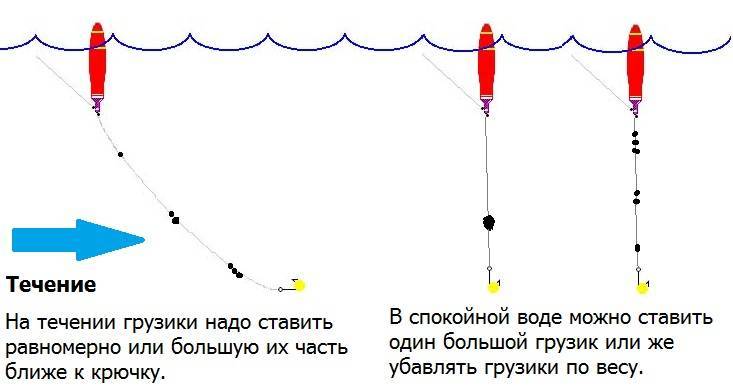
Since they catch small trout at the Fishing Festival, they use ordinary spinning rods; rarely anyone uses special gear.
They use various floats, whatever they can do (weighing from 2 to 10 grams) - the heavier the equipment, the further from the shore you can throw the tackle. Sinkers are used, again, by anyone - either one through sinker, or a chain of small pellet weights. Below the weights there is usually a small swivel, to which a leash a little thinner than the main line is attached. While you can use a fishing line of 10lb or more on the bottom without any problems, it is difficult to throw floats with such a fishing line. It is best to use 8lb or 6lb monofilament, and for the leader take a line 2lb less than the main line.
To catch trout using float rigs, earthworms, artificial salmon eggs and other sinking artificial baits are again used. As I wrote above, you can fish with paste, but it hangs in the water column and can rise above the sinker, so the bite will not be immediately visible and you cannot accurately determine the depth of the paste.
7. Fishing with a float.
In small rivers and streams they often fish using a fishing line with a float, i.e. let the rig go with the flow, sometimes holding the float. In this way, you can fish promising sections of the river. Since wild trout are caught in this way, and not bred ones, the size of the trout can reach sizes of more than a kilogram. An artificial egg or plastic bead, located a few centimeters above the bare hook, is used as a bait.

Live earthworms are well suited for float fishing and for donkey fishing. For active fishing (spoon with a leash, equipment for active retrieving), it is better to use artificial bait.
Local stores have a fairly wide selection of different lures for trout fishing. For myself, I chose several different types: artificial salmon eggs, floating paste and “marshmallows,” silicone worms and larvae.
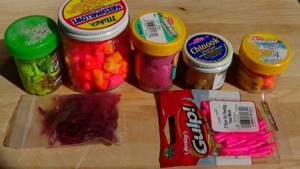
Artificial salmon eggs are very soft and quite elastic. Soft eggs emit a lot of attractant (special flavors to attract fish), but they tear very easily when bitten, so they are practically disposable. I put it on the hook and after the bite there was nothing left.
More elastic eggs stay on the hook better; after catching a fish, the eggs remain on the hook, even if they are “bruised”. Well suited not only for a float, but also for vibrators with a leash, for active retrieving, and for donkeys.

Silicone worms have proven themselves well on spoons with a leash, on small jig heads, and on float rigs when fishing in currents. I had good fish in both classic red and bright pink.
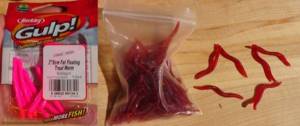
It is best to plant several larvae . They are bright and emit an attractant. They stay on the hook well. In addition to trout, you can also catch perch and other small fish on them. Suitable for float fishing and lure fishing with a leash.

They can be mounted as a chain, i.e. like an earthworm with a “stocking”, or you can, like a bunch of maggots, thread several pieces with a hook through the thin part of the larva.
The floating paste should be rolled into a ball and placed on a hook, or better yet, on a tee. A long leash on the donkey allows you to adjust the height at which the bait hangs at the fish feeding level. If the hook is heavy enough, then it is worth making a larger ball in order to “lift” the bait from the bottom of the reservoir. The same applies to the marshmallow . This is a soft bait, like a marshmallow, that gets wet quite easily and falls off the hook in the current. Therefore, floating baits are best used on lakes and ponds.

How to properly attach an artificial salmon egg to a hook
Artificial salmon eggs, especially dense ones, stick well to the hook. There are several ways to attach eggs, one at a time, two at a time, or even three at a time.
Here is the easiest way to attach eggs so that they do not fly off the hook when casting.

You can also leave the point of the hook open, if you take a larger hook, you can add other elements to the egg, you can even use a tee.
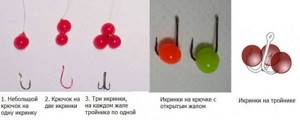
It is best to pierce delicate eggs with thin hooks; thick ones can tear them. Well, the sting of the hooks should be sharp enough so that the eggs are pierced and not burst.
Summary: The above is quite enough for trout fishing at the Fishing Festival in Montreal and the surrounding area. You can find useful and interesting information about fishing for wild trout here - “Trout fishing in rivers and streams. Practical guide from DZ."
Source: rybalkavmonreale.ru
Fishing methods
Depending on the characteristics of the reservoir in which the trout lives, you should choose a fishing rod and bait. You can fish successfully with both artificial and natural baits.
Spinning fishing
Many anglers, when choosing trout gear, take into account the predatory tendencies of the fish. Spinning is a universal tackle that allows you to fish both on paid ponds and on small rivers. But there are serious differences in fishing techniques. If you can use light baits in still waters, then in the current you have to make the equipment heavier. The choice of wiring depends on the fishing location and the type of bait. To animate rotating spinners, uniform wiring is used, and the use of a wobbler requires the angler to be able to make a jerking retrieve. Sometimes good results are achieved by stepwise wiring of twisters or vibrating tails.
Bombard
When it is impossible to cast light artificial baits long distance with a spinning rod, effective trout fishing is carried out using a bombard (sbirulino). A distinctive feature of the gear is a special float. Its task is to make the equipment heavy. Thanks to this design, it is possible to throw the smallest spinners and wobblers far. For clear water, plastic water-fillable models are best. In addition to spinners and wobblers, you can fish with bombarda with natural bait.
Donka
Traditional gear that has been used on rivers for a long time includes donka. This fishing rod allows you to make long casts of edible baits. To prevent the current from carrying the equipment away from the selected point, the fishing rod is equipped with a heavy sinker. The best time to fish with a donkey is after heavy rain, due to which the water becomes cloudy. Often the gear is set at night, and in the morning fishermen remove the prey from the hook.
Feeder
Feeder trout fishing has several significant differences from classic fishing. When equipping a feeder, it is necessary to take into account that trout feed in the water column. Therefore, the bait should hover in a certain horizon, and not lie on the bottom. An advantage of the English donkey is the presence of a feeder. Thanks to bait, it is possible to gather a large flock at the fishing point.
Surface fishing
With the arrival of summer, the pestle rises to the upper layers of the water, where it catches fallen insects. This is the best time for fly fishing. The tackle allows you to use imitations of insects, realistically floating the bait downstream.
You can fish from the surface using a float rod. In this case, natural baits are used.
Catching the line
Trout instantly reacts to food objects passing by. This feature of the fish is used by lovers of float fishing with retrieval. Very interesting places for such fishing are rifts, whirlpools, and the boundaries of direct and reverse currents. Previously, the main bait for such fishing was a worm, but today paste shows good results.
Autumn features
Trout live only in clear water. If there are fish in a pond, then we can talk about its cleanliness. Prey is caught in places where there is enough food: beetles, dragonflies, grasshoppers, larvae. This is a comfortable environment for trout, where they feel safe. Therefore, it is possible to catch trout in summer using a fishing rod.
In winter, fish activity decreases, but this does not eliminate the opportunity to catch it. It’s just important to select promising places - rivers with flow, because they are not covered with a layer of ice. Sometimes it is worth fishing in drilled holes, but this is difficult to do, since it is not always possible to discover where the fish live.
On the river
Brook trout is found in the pits of mountain streams. For these individuals, it is important that there is abundant vegetation near their habitats. It is good to choose rivers with snags and trees that have fallen to the bottom.
A fisherman should go:
- to mountain rivers, where the bank is steep and overgrown with greenery;
- to fast rivers where there are rocky obstacles;
- in areas with slow flows, where there are rubble, there is plenty of aquatic flora.
With such a current, trout fishing requires special care from the fisherman so as not to spook it.
On the lake
Lake representatives love deep reservoirs in which the water is clean and cold.
Where to go fishing:
- to dam lakes, in which the water is cool, clear, and fairly clean;
- to the shores of lakes, over which tree branches hang.
After the ice melts, lake representatives stay in shallow water because the water is warm enough and there is also a lot of food. Gradually, as the temperature increases, the inhabitants go deeper, where it is cooler. In hot weather, prey lies in deep water.
Trout fishing involves depending on the time of year and weather. Fishermen take into account seasonality factors:
- In the spring and, in general, in warm weather, fishermen fish at shallow depths. The heated upper water layer provokes insect activity. Trout rises to the surface for prey, and at the same time, to bask in the rays of the not scorching, but warm sun. Fishermen fish at shallow depths and in shallow waters.
- In hot weather, trout sink to the bottom in search of cool holes and depressions. Its activity is low, but using attractive baits, fishing from the bottom has a chance of success. In the hot months, trout fishing produces results in the evening and in the morning before the air temperature rises - the time of active feeding for trout.
- In moderately warm autumn weather, with a gradual cooling, fishermen are rigging a fishing rod to catch trout for caviar. During spawning, the fish is active and voracious, attacking many baits with aggression. They look for it upstream, in shallow water, in quiet rocky breeding areas.
- In winter, an excellent bite is guaranteed on the first ice. The trout tries to eat enough and descends into the bottom water environment for the winter.
In the fall, trout go to spawn and, unlike other fish, feel most comfortable. She behaves very aggressively, and you can catch her literally anywhere. At any depth or distance from the shore. When going to spawn, the fish actively gains weight and rushes to any bait.
In autumn, it is forbidden to enter the water when fishing, as you can damage the eggs. You need to fish from the shore or from a boat. Trout is difficult to catch in heavy rain and frost. But it’s best just after these unfavorable conditions.
Trout paste is ideal for autumn fishing. The fish does not hesitate for a second before swallowing a lump of paste that exudes an incredibly attractive aroma.
Trout is a cunning and beautiful fish, and also has excellent taste. Fishing for trout with paste requires attentiveness and patience, but always rewards very generously.
Are you interested in fishing gear for smelt in winter? Our article will tell you about this. Here you will learn how to properly catch asp using a spinning rod. On our website https://lovisam.net there is still a lot of interesting and useful information about catching different types of fish.
The usual habitat of trout is Lake Ladoga, Lake Onega and reservoirs of Karelia and the Kola Peninsula. Some of its species are found in the Caucasus and Transcaucasia (for example, Lake
Sevan). She usually prefers small fish, insects and their larvae.
This type of trout has the following characteristics: red, orange spots with a light rim. The standard weight of an adult is 300-500 g, but there are also specimens weighing 1-2 kg.
This mass is due to the characteristics of the trout’s habitat: the rapid and at the same time cold current is not very conducive for the vital activity of aquatic life, therefore, this fish spends most of its life in semi-starved conditions and has adapted to be content with little.
In the summer, acceptable habitats for this representative of the ichthyofauna are areas shaded by trees, the boundary line between the current and clear water, places between large stones, and steep banks.
In water areas with calm water and warming temperatures above 20 degrees, the chances of successful fishing are reduced to a minimum. But clean reservoirs saturated with oxygen, on the contrary, show high efficiency.
Float tackle has long been used for trout fishing. A fishing rod can be either the simplest (fly) or quite sophisticated (plug). The catch will depend on the proper configuration of the gear and its correct use.
- A prerequisite for catching wary fish is a long rod (5-10 m). It allows the fisherman not to come close to the water's edge.
- To catch large fish and cast over long distances, you will need a spinning reel with a 2000-3000 spool.
- The best option would be to equip the fishing rod with light blue monofilament with a diameter of 0.20-0.25 mm.
- To make a leash, you will need meter-long pieces of fluorocarbon thread with a lower breaking force than the main fishing line.
- The hook is selected to match the bait, but taking into account the size of the intended trophy. Experienced fishermen recommend tying hooks No. 6-8.
- Lead olives and pellets, as well as sheet material, can be used as a sinker.
- The float should be dim and small; a spindle-shaped body would be a suitable shape for the alarm. When fishing in the current, spherical floats are made from cork.
And here's what you need to know: How to make a donka from a spinning rod
The use of paste for trout fishing has its own characteristics, where the main factors are weather conditions and time of year. It is especially difficult to use the paste in winter. As a rule, this requires certain skills, experience and dexterity.
With the onset of real cold weather, trout become quite picky about food. Her sense of self-preservation is heightened, and she reacts to any noise that alarms her.
In this regard, taking into account such factors, it makes sense to adopt some recommendations. For example:
- In cold weather, you should mainly rely on baits with a large capacity of aromatic substances. In addition, it should contain elements that additionally attract trout, for example, sparkles. This is necessary because in winter the activity of fish in general decreases and trout is no exception.
- Even in such conditions, it is difficult to determine where the fish are, since they do not stay in one place, but migrate throughout the reservoir in search of food. In this case, you will have to fish all horizons, from the surface to the very bottom.
- If you bite and catch a fish, you need to move on to the next hole, since catching two fish in one hole is unrealistic. She will immediately move away from this hole, sensing danger.
- In regions with warm winters, the use of paste does not differ much from other fishing seasons.
At the end of winter, when the ice has already begun to melt, trout become more active, but catching them is still not so easy.
The most active bite is observed in the spring, when the snow has already melted. In such conditions, catching trout is possible, but taking into account certain factors, such as:
- The right choice of place for fishing, taking into account the characteristics of the reservoir. Fish can be found within the rifts, where the water is saturated with oxygen, but there is no strong current.
- In spring, trout prefer food of animal origin. In this regard, it is better to choose pasta with a fish or shrimp flavor. Such a bait can be more effective than any wobbler.
- It is better to use a slow, steady retrieve and floating bait, as trout will not chase a fast-moving bait in the spring after wintering.
In the summer, the bite and activity of trout decreases significantly. This is due to the fact that trout prefer cold water and cannot tolerate direct sunlight. Therefore, in order to catch trout, it is better to listen to the following advice:
- When fishing in summer, it is better to give preference to bombard or bottom tackle to increase the casting distance and try to get trout from the depths. During this period, trout tries to stay in depth and away from the shore, as well as in the shade of aquatic vegetation or trees.
- The best option is to use sinking paste, since the fish tries to go to depth, especially during very hot periods.
- The best periods for fishing are considered to be morning and evening, when the heat has not yet set in and when the heat has already subsided. It makes no sense to catch trout at night, since during this period there is enough food for it. During other periods, except morning and evening, it is better not to hunt trout. Although there are periods of cold weather even in summer, then you can count on a trout bite.
With the arrival of autumn, the task of catching trout becomes much easier. This is due to the fact that during this period she goes to spawn. In this regard, it behaves much more actively, and you can catch it anywhere in the reservoir. During this period, she loses her sense of danger and can safely take any bait. Despite this, trout fishing during this period is associated with certain recommendations. For example:
- It is not recommended to go into the water, as the laid eggs can easily be damaged.
- Do not fish for trout in sub-zero temperatures as there is virtually no chance of catching trout. During periods of warming, a significant increase in biting can be observed.
- During this period, any paste with any flavor will do. This is due to the fact that before spawning, trout stock up on nutrients and take bait at any depth.
Fishing rod equipment
Trout fishing also leaves its mark on the set of gear. There are certain adjustments that need to be made to each rod.
Spinning
To hunt for trout with a spinning rod, you need to make a light but durable fishing rod. The gear has some differences when fishing on a river or in a pond.
- The length of a fishing rod for river fishing is limited to 2.4 m. Usually it is an ultra-light spinning rod with a casting weight of up to 10 g. It is more convenient to make long casts in ponds with a fishing rod of 2.7-3.0 m. These are light or medium-class models with a casting weight of up to 20 g.
- The tackle is equipped with a spinning reel 1000-2000.
Before fishing, it is important to accurately adjust the friction brake. After the bite, the trout makes sharp jerks that can break the fishing line.
Source: fishelovka.com
Fishing Features
One of the most prominent representatives of salmon fish is rightly called brook or lake trout. Catching a trophy specimen is quite difficult; only true professionals can cope with such a task. Despite this, trout is the desired catch of every fisherman, so many of them go to paid reservoirs to catch a large fish with their own hands. This excitement is caused by the difficulty of catching and the incredibly tasty meat of this fish.
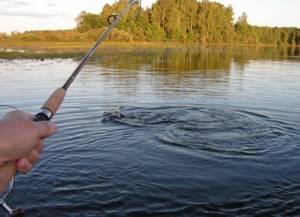
To catch trout, you need to know what places it prefers and where it hides during spawning. A large number of fish can be found:
- in fresh reservoirs with clean and cool water;
- in mountain lakes with cold, crystal clear water;
- in paid trout reservoirs;
- at depth in shady places where direct sunlight does not penetrate.
Finding a fishing spot is only 40% of successful fishing. The correct equipment, bait, and technique play a big role in such a complex matter. Despite the fact that experienced fishermen use spinning rods equipped with artificial bait to catch trout, trout paste is becoming increasingly popular among them. It is strung on the hook of a bottom or float rod and attracts fish with its bright color and strong aroma. A special mass can be purchased at a fishing store or made with your own hands.
How to assemble the tackle correctly
A fishing rod for trout should be long, 5-6 m. Such a rod will help you make long casts and at the same time be at a distance from the fishing spot so as not to spook the prey.
Since the rod must be held in your hands throughout the entire fishing, the product must be light. Therefore, you should not choose fiberglass, even if it is inexpensive. Otherwise, your hands get tired while fishing. A fishing rod made of carbon or carbon fiber weighs lighter.
And here’s what you need to know: Donka for fishing, types of donoks and bottom gear with photos and descriptions
The coil may be inertial. It is not necessary to buy a modern inertialess one; it will make the tackle heavier.
How to assemble the equipment correctly:
- the main line is passed through the float;
- install a stopper necessary to prevent the float from hitting the weight;
- attach a swivel that can protect the equipment from getting caught, the product will ensure that there are no problems when hooking and casting;
- A removable leash is installed behind the swivel.
It is worth attaching hooks of the required sizes to each leash.
Since fish are caught in clear water with a rod, trout requires the thinnest possible equipment. The line must withstand the resistance of the prey when the fisherman reels it in. At the same time, the material is invisible in clean water.
A sufficient diameter of the fishing line is 0.2-0.25 mm, the leader is 0.18 mm. With a small diameter, the strength of the material is high. Experienced fishermen do not recommend using rougher rigs, as this may scare trout away from the bait.
Hooks
For trout fishing rods, it is recommended to use 6-9 hooks. It is worth fishing with tackle that only has one hook attached. You should not use the second one, as this can reduce the number of bites: the fish is careful.
The main characteristics of the hook are that it must be strong and sharp. Those who are going to fish with paste need to choose products that have a spring on the fore-end. This way the bait stays on the hook longer.
Floats
It is better to choose oval, teardrop-shaped or spherical floats for trout. It’s good if the product has antennas of bright colors. Such gear helps when using any attachment.
Fishing stores sell float gear designed specifically for catching this type of fish. The products are made taking into account the characteristics of trout biting behavior.
Assembling a summer and winter trout fishing rod with your own hands:
- The fishing line – 50 m – is passed from the reel through the rings of the rod.
- The cambric is attached to the fishing line.
- The fishing line is threaded through the float ring.
- The float is fixed into the cambric.
- A figure-of-eight knot is used to tie the leash to the main line.
- A hook is attached to the leash.
- The fishing rod for trout fishing is loaded with lead pellets experimentally, taking into account the presence and strength of the current in the reservoir. From the hook at a height of 15–20 cm.
Rigging a trout fishing rod requires quality equipment and materials, without bright colors.
Advanced fishermen use an American self-hooking rod to catch trout. Its peculiarity is a “cutter” equipped with a mechanism with a spring, similar to a mousetrap.
Which equipment to choose
Equipment for trout fishing with paste can be very diverse, thanks to which many anglers can abandon expensive spinning rods, preferring a float rod, feeder or bombard. Despite this, any tackle must meet certain criteria. You need to be able to choose the right fishing line, hooks, reel, adjust the leash, etc.
Float rod
This type of tackle belongs to budget type fishing rods; there are no special requirements for it. But in order for lake or brook trout fishing to be successful, it is recommended to adhere to the following criteria when equipping a float rod:
- length of the form - not less than 3 and not more than 4 meters;
- line diameter - 0.2 mm;
- thread length - 50−100 meters;
- a leash 0.18 mm thick, which is attached to the end of the fishing line, its length should be about 50-60 cm;
- hooks numbered 10-14, depending on how large a trophy you want to get.
A float and a reel of any type are suitable for equipment . But it is advisable to use a floating type of paste .
Bottom tackle
This rod is especially popular among fishermen, because it allows you to fish in areas of the reservoir remote from the shore. Another advantage of bottom tackle is the opportunity to catch large fish that prefer to lie at the bottom of a lake or river. Modern donks are equipped with a feeder rod, which simplifies the fishing process. Equipment for trout fishing on a feeder should be as follows:
- rod length - from 2.5 to 3.3 meters;
- inertia-free coil;
- quick-release weight;
- fishing line, the thickness of which varies between 0.15−0.25 mm;
- a leash made of thread 0.2 mm thick and about a meter long;
- hooks from No. 8 to No. 12, depending on the size of the intended prey.

This fishing method involves the use of sinking type paste. For successful fishing, it is better to use nylon lines.
Bombard with float and sinker
An unusual rig that is rarely used by fishermen, but can be indispensable when it comes to trout fishing. To create it, a sinker and a float are used. It is best to use a weight made of brass or lead, this will allow you to throw the tackle as far as possible. The bombard itself should be transparent or translucent so that the fish cannot notice it in the water column.
The fishing technique is as unusual as the equipment itself. After a long cast you need to make a slow retrieve. While retrieving the fishing line, you should take short pauses so as not to spook the wary trout.
A little play with bait will be a big plus while fishing and will help increase the number of successful bites. The best bait for bombarda is floating paste.
Fishing with pasta in summer
Summer is the least favorable time for fishing with pasta. Trout always hide from the heat far from the shores and surface, and come out to hunt only at night. You can, of course, approach by boat, but most likely the fish will get scared and swim away. At night she has enough prey. You can catch trout using pasta only in the early morning, when it has already had its fill, but has not yet sunk to the bottom.
It is much more effective at this time to fish using fly rods and plug rods. But at the same time you need to have sniper casting accuracy. And cast very gently so as not to scare away the fish.
And here’s what you need to know: Do-it-yourself winter lures for perch, photo drawings, video
Fishing with pasta in the summer is suitable only for those who value the process of fishing, and for him the catch is a secondary matter.
Rods with long-distance bait casting are very successful in trout fishing. You can use both sticks assembled from various components and match elements for the corresponding purpose. Match fishing rods, taking into account the device test, can be light, medium and heavy. All classes of such sticks are used, since trout are caught both near the shore and far from it.
A standard spinning rod with a semi-parabolic action and a whipping tip performed quite well. This configuration allows you to throw tackle with 10-40 g of dough at a distance of 15 to 40 m from the shore.
This method is relevant for fishing in lakes and ponds. You can equip a spinning rod with a regular spinning rod.
As for the choice of scaffolding, the best option is a braided line with a thickness of 0.12-0.14 mm, as well as a durable monofilament with a cross-section of 0.3-0.35 mm. The leash is also made from monofilament fishing line 0.2-0.25 mm, and the recommended length is at least 50 cm.
It is best to use lightweight basalt or foam floats. The use of Wagglers is appropriate here, but it is recommended to use weighted versions together with stabilizers.
A pear-shaped float with a rod is best used for fishing for shrimp and fry. Recommended float test: from 5 to 40 g. The weight of the sinker can correspond to the weight of the float and be slightly less, since the bite is visible even when the alarm is in a reclining position on the surface of the water.
Another advantage of a float tilted to its side is its play on waves in strong wind conditions, which contributes to additional movements of the bait. This does not scare the fish at all, but on the contrary, contributes to the intensity of the bite.
When bottom fishing, the nozzle should be fixed 10-40 cm from the bottom surface. The bait for this is installed on a fishing line near the float.
Fishing, which occurs at a depth of 1.5-2 m, requires that the sinker be close to the float. In this position, the oscillating bait behaves well and attracts fish perfectly.
It is worth noting that for effective fishing it is recommended to move along the reservoir in the opposite direction from the current. This moment is determined by the location of the trout: its head is directed towards the stream, therefore, it cannot notice the fisherman approaching it. The ideal option is to move against the current, which achieves 100% camouflage.
If you have the skills to move quietly, then you can successfully fish along the shore, moving towards the flow. Here it would be appropriate to cast both with and against the current.
And one more interesting nuance: if you remain quiet when approaching the lake and do not let your shadow fall on the surface of the water, you can notice the trout biting right at your feet. However, it is advisable to have polarized glasses to protect your eyes from the sun's rays reflected by the water.
They provide an opportunity to examine the biting process itself. A prerequisite for successful fishing is to cast the bait as close as possible to the potential habitat of the fish.
Numerous observations show that hungry trout do not overuse spinning rods.
The main thing is that they naturally reflect the movements of the fry, frog and other aquatic inhabitants. Among the huge variety of spinning baits, the following can be noted: small-sized rotating spoons, medium-sized oscillating spoons, poppers, wobblers, worms made of plastic material, silicone fish, vibrating tails, twisters, etc.
In places where there are not so many anglers, trout are caught on small-sized perch spinners, in particular
, Myran, Aelita, etc. With the constant use of rotating spoons, the trout’s interest in them is significantly reduced, or even disappears altogether. In this case, you will have to change the bait to a more entertaining one.
The most popular are:
- wobblers of the Duel F 198 L Minnow brand with colors M100, M92 and M102, the weight of which is 3.5 g - capable of going deep up to 1.2 m;
- Rigger brand C Ultiva is a floating type of wobbler;
- Pontoon 21 brand models are representatives of new high-tech developments;
- The Cheerful 40 F (floating) and Cheerful 40 SP (suspending) wobblers are available in weights of 2.5 and 2.7 g, sufficient for intriguing movement regardless of the type of wiring.
One significant drawback of all the listed wobblers is their high cost.
Spinnerbaits are also relevant when fishing for trout. The design of the nozzle consists of one or two petals fixed on the rocker along with a weighted hook.
Typically, the load can be found in the form of a fish, octopus (octopus) with a fringe that fluffs up with alternating wiring, which looks very advantageous. It is advisable to choose the color of the petal taking into account poor visibility in water and the time of day.
The most popular are yellow and silver, that is, on a bright day it is recommended to give preference to a duller bait and vice versa. The Aelita brand spinnerbaits performed well.
Vibrating tails and twisters of light to medium size are ideal for trout fishing. As a rule, fastening of soft baits is carried out using a rotating connection of a sinker and a special hook with a special Z-shaped structure (offset hook).
This gives the bait an enticing look and increases its grip. The size of the jig head used or the same offset hook directly affects the dimensions of the silicone bait used.
The most suitable models of trout vibrotails and twisters are from 2.5 to 6 cm. The color palette can consist of yellow, blue, white with a red head.
Vibrator tails with transverse cutouts on the sides of the body are a favorite bait for trout. There are models that contain a small weight.
This design allows you to do without additional loading. It also doesn’t hurt to have twisters with a sound or glowing effect in your assortment.
A little-known tackle called a boat copes with its functions quite successfully. The essence of the boat is this: with the help of the wind, it moves along the water surface and attracts fish. This gear is made independently. You will need the following materials:
- for the body - pointed varnished board 25-30 mm thick;
- for the mast - a processed durable stick or a lightweight aluminum rod;
- for the sail - a piece of plastic with a soft structure;
- 2-3 leashes 0.5-4 cm long, attached to the main fishing line at the back of the boat.
You can secure the leashes using a carabiner and swivels. The thickness of the main line is 0.4-0.45 mm, and the cross-section of the lead line is 0.2-0.25 mm.
The optimal hook size is No. 4-8. Boat fishing is effective mainly in the morning, when trout are extremely hungry.
In this state, the fish prefers to feed in the shallows, where the likelihood of finding food is high. Since fishing in shallow water is much more difficult due to the wariness of trout, it is the boat that allows you to easily deliver the bait to the desired location.
Summer trout fishing is a truly exciting activity where you can not only show off your knowledge and skills, but also experiment and discover something new.
In summer, you need to look for trout in shaded areas of the reservoir, under steep banks, at the border of the current and calm water. If the water warms up above 20˚C, the fish stop biting. Only in clean waters that are saturated with oxygen do trout continue to actively feed.
In the summer, you have to use gear that can deliver bait far from the shore. Most often, anglers use spinning, fly fishing and feeder. During mass flights of insects, surface fishing using natural baits or their imitations becomes successful.
Types of pasta
Adult trout feed on small fish, frogs, insects, larvae and crustaceans. Despite this, fish are willingly attracted to bright trout paste. It contains various aromatic additives that attract adults. And the bright color of the bait irritates the trout and makes them want to swallow it.
The paste is sold in small jars. It can easily be purchased at a fishing store. On paid reservoirs it is issued if the fisherman rents gear. There are only two types of bright bait:
- Sinking paste, it is quite dense, so it quickly sinks to the bottom to attract large fish. The colorful, elastic mass is perfect for fishing with bottom tackle and performing quick retrieves.
- A floating paste that floats in the water column for a long time, after which it slowly reaches the bottom, if it does not become prey for trout before this moment. It is used when fishing with a float rod to catch specimens located on the middle horizon or on the surface of the water.
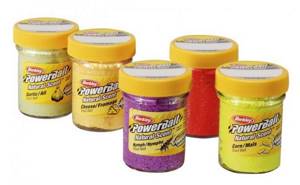
Although trout paste is inexpensive, it is not necessary to buy both types. To make the floating type heavier, just add a piece of sinker or a small lead ball, after which the bait will sink to the bottom. The sinking type bait can be made lighter by mixing it with foam balls.
Regardless of the type of paste, it contains the same components - a concentrated protein mixture, natural or artificial flavors, and dyes. The result is a mass with a pungent odor. To catch trout, it is better to choose a paste with a garlic, cheese, fish or caviar flavor. The color of the bait should be bright, it is good if the mixture is supplemented with sparkles.
DIY bait
Experienced fishermen know that it is not necessary to buy pasta in the store; you can make it yourself. The cheese mixture showed excellent results while fishing for trout. Composition of trout paste with your own hands:
- You need to take 2 raw chicken eggs, break them and pour them into a bowl. Add a little milk to the egg mixture and beat the ingredients thoroughly to obtain a homogeneous mixture, as for an omelette.
- The finished mass is poured into a dry frying pan. The products must be constantly stirred and fried until all the liquid has evaporated.
- Trout feed is added to the egg-milk mixture, which can be purchased at any pet store. An appropriate addition would be cyclops and daphnia (1-2 glasses, depending on how much of the finished product is needed for fishing). These components are ground into flour and also added to the omelet.
- The main ingredient in homemade pasta will be cheese with a strong smell. It is grated on a fine grater and added to the mass. Chopped fresh herring or sprat is another indispensable component of cheese bait.
- At the very end, you need to add canned corn in the form of puree (you can grind the product with a blender or through a meat grinder). To ensure that the mixture is well mixed, corn juice from a can is added to it.
All components are thoroughly mixed. The cheese spread for trout fishing with your own hands is ready, you can go fishing.
Putting pasta on a hook
Using trout paste is quite simple and convenient. After a few trainings, setting the bait will take no more than a minute, and your skills will improve. The entire process of stringing pasta onto a hook can be divided into several stages:
- First you need to pinch off a small piece of the mixture, roll it out on your palm and form a small ball in the shape of a pea.
- Next, you need to immerse the hook in the paste so that it is not noticeable. If any part of the hook remains uncovered, the fish may get scared. You need to attach the bait firmly so that it does not disintegrate in the water.
- After this, you need to give the bait a round or oval shape.
In the store you can buy a special paste mold that can turn an ordinary pea into a fry, mussel, larva or bug. This bait will look more believable and realistic, which will help attract the attention of trout.
Features of fishing
When fishing for trout with paste, equipment plays an important role, but the time of year and weather conditions are equally important. In summer, the fish lies on the bottom, because it prefers cool places. In winter, adults are especially picky about food, their sense of self-preservation is heightened, so any careless movement can scare off the prey. For fishing to be successful, you should know in advance what bait, tackle, and fishing technique to use:
- In winter, it is better to use bait with a strong aroma and attractive appearance. A paste with glitter and garlic flavor is suitable for this. If fishing is done from ice, then you should make several holes at once and fish them one by one. You can explore both the bottom and the upper layers of water, because the fish constantly wanders in search of food. If you bite or catch a trout in one of the holes, it is better to immediately move on to the next hole.
- In early spring, the trout bite is at its peak. Catching a trophy specimen becomes easier if you follow certain spring fishing conditions. For fishing, it is better to choose places with rifts and gentle currents. At this time, the fish prefers to eat animal food. A pasta with a fishy or shrimp flavor would be an excellent choice. When fishing, use a slow, steady retrieve and floating bait.
- In summer, trout activity decreases. Catching her is quite difficult, but possible. To do this, in the summer it is better to use a bombard or donka, because the fish lies on the bottom in search of a cool place. You should look for trout at depth, in the shade, near underwater vegetation or trees. Sinking paste is used as bait, and the best time for fishing is early in the morning or evening.
- Autumn is the most favorable time of year for catching lake and river trout. In the autumn, this representative of the salmon family goes to spawn, so it leads an active lifestyle. You can catch a trophy specimen anywhere in a body of water. Any bait and tackle is suitable for fishing. In autumn, fisherman should not go into the water so as not to damage the eggs. On cold days there is almost no bite; it is better to go fishing when it gets warmer.
Regardless of the time of year, it is enough to follow these rules of seasonal fishing, and a large catch of trout for pasta will not take long to arrive.
Bait supply
Unlike conventional feeder fishing, when fishing for trout you need to try to make sure that the hook with the bait does not sink or lands very slowly on the bottom. To achieve this effect, you can add some kind of buoyant material to the nozzle, for example, a piece of foam. The leash itself is best made from nylon coated with fluorocab. Such a fishing line will become as invisible as possible to the fish, while having sufficient elasticity.
We recommend reading: Description of grayling fish
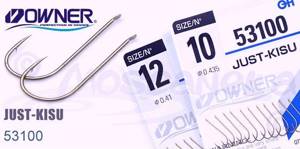
It is better to use light-weight trout hooks with a long shank. Size according to Owner classification 10 or 12. The elongated shape of the hook is needed for better detection of fish that bite at mid-water. In addition, the design of such a hook allows you to easily place an element of floating material.
The best live bait for trout fishing is a bunch of bloodworms or maggots. On some days, a sandwich made from these larvae works better, especially when bloodworms predominate.
Fish can bite in different layers of water, so it’s better to start with a short leash, 30 cm long. If the fish likes the bait, the bites will most likely begin at the bottom. It often happens that trout are interested in bait, but swim higher, picking up sinking particles. In such cases, you will have to experiment with the leash, gradually increasing its length. When experimenting with the length of the leash, it makes sense to recast after 5-10 minutes. You need to increase the length of the leash gradually, 10-20 centimeters at a time, changing the color of the foam ball.
The trout bite greatly depends on both the size and color of the bait. The best colors for light hook bait are yellow, red and green. It is advisable to have maggots of different colors with you.
At the beginning of feeder fishing, it is important that the trout make their presence known. When you manage to see the first bite, it becomes much easier, you can call it half the victory.
Although trout is a predatory salmon fish, fishing for it with a feeder often outperforms spinning rods in terms of effectiveness. Most likely, the point here is that the fish really responds well to bait.
Some useful tips
Many fishermen claim that fishing with pasta is completely ineffective . In fact, a negative result is a consequence of improper use of trout paste. Here are a few mistakes that anglers make when going to a body of water with paste bait:
- Improper storage of the product. Due to the fact that the paste often contains natural ingredients, it can easily deteriorate or lose its properties. In order for the bait to retain its unique aroma and attractiveness, it should not be stored in the freezer or in a place with sub-zero temperatures.
- Product savings. If you want to get a decent catch, you should never be greedy. Hungry trout are constantly searching for food in order to stock up on enough nutrients. The larger the volume of the bait, the better and more successful the bite will be.
- Incorrect installation. When in contact with water, the paste may fall apart, especially if fishing is carried out on a river with a strong current or on riffles. Before throwing the bait into the water, it should be thoroughly compacted with your fingers.
These little tricks will help you quickly catch the long-awaited trophy. Proper use of the paste will immediately dispel all rumors about the ineffectiveness of this amazing bait.
The use of trout paste does not require a lot of experience, skills and knowledge from the fisherman. Thanks to the attractive, fragrant, bright bait, even a beginner will be able to catch such a cautious fish. You just need to choose the right gear and use the right fishing technique.
Source: ribalka.guru
Where to fish for trout
Under natural conditions, river trout fishing is organized on fast, cold streams with depths of no more than 1-1.5 meters. As a rule, the bottom bases of rivers suitable for fish habitat are hard rocky or pebble areas of different levels. Riffles, rapids, and rapids of a stream with areas of relatively calm water are always feeding grounds for this type of salmon fish. Under natural conditions, individuals rarely stay in places with aquatic vegetation, preferring open areas of water areas, where it is better for them to navigate, looking for food in the form of insects that have fallen into the water stream and small helpless fish drawn into the rapid current of the river.
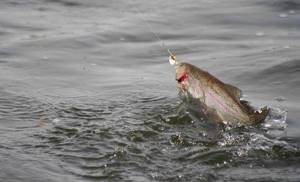
Fishing for trout on a platform is radically different from the conditions of the natural environment. Artificial ponds are mostly stagnant bodies of water with depths of up to three meters and clayey bottoms, surrounded by various vegetation. The boundaries of the depth difference and the squiggles of individual sections of the pond make these places a stopover for fish and their hunting grounds. Trees hanging over the water, shading the water surface, always attract trout due to colder water and the presence of a significant amount of food objects falling into the water from leaves and branches, becoming easy prey for fish. The walls of the coastal reed thickets do not go unnoticed, where the predator plies in search of small things, combing trajectories that follow the contours of the coastline.
Fly fishing for trout
Fly fishing for trout is one of the ways to hunt this beautiful fish from the salmon family. It is not simple, but very exciting, allowing you to enjoy the process as much as possible.
Where and when to fly fish for trout
Choosing the place where you are going to catch trout is perhaps the most important thing for effective fishing. Even knowing that there is this fish in the reservoir is not a guarantee that you will catch it. You need to know specifically the areas where she bites, the nuances of her command in different periods and many other little things. All of them are learned during periods of fishing, in communication with other fishermen.
Trout spawning time is autumn, so its fishing season begins in the spring, immediately after the ice disappears from the reservoirs. If it does not freeze in winter, you can count on success in this cold time. Although in winter trout are not very active and its capture is generally difficult to predict.
Trout become more active after meltwater begins to flow into the reservoir. The ground at this time is still frozen, so the latter does not yet pollute the reservoir, in which the water remains clear. The latter has a negative impact on catches - you shouldn’t have high hopes for catching trout.
In the spring, trout still hold on to the places where they spent the winter. Usually these are riffles in places where there are turbulences. It is present in areas with little current. Such places are full of food, which is the main reason for trout to be there.
After the water level begins to rise, the latter becomes polluted and becomes cloudy. Trout leaves their winter places and “scatters” throughout the entire reservoir. Finding her is becoming difficult.
In the trout fishing procedure itself, there are three seasons:
- April-June: it is characterized by a water temperature level that is not yet maximum for the reservoir, and fairly high fish activity; The best time for fishing is after lunch;
— July-August: the water is already well warmed up during this period; trout fishing is more effective in the early and late hours; biting activity varies, but much lower than in spring;
— September: this is the time of a surge in trout biting activity; You can fish all day.
Trout are inhabitants of fast and cold rivers, which often look like wide streams. She lives in small, but also cold lakes. In such reservoirs, besides it, there may not be any other fish at all. It also lives in large lakes; in the latter, other species of fish live together with it.
You need to look for it where the current is strongest, where the flow is greater and, naturally. The water is more saturated with oxygen. These conditions are the most favored by trout. By the way, the water temperature, which is the most comfortable for this type of fish, should not be higher than +20°C. If it is larger, then there is no longer any hope for trout activity.
In summer, trout stay in schools in places with the fastest currents. They may be on the border that separates such areas from those where there is no current or it is weak. You can find fish behind boulders, in the quiet water behind them, where they like to rest.
Larger trout should be looked for in deeper sections of rivers, behind shelters such as trees and snags fallen into the water. She also loves places near steep, steep banks, areas where there are sharp changes in depth.
Trout should be caught at mid-water. It is in such layers that it is most often located, waiting for a fish swimming past, insects that fall to the surface of the water, or your bait. Fish are often found at the very surface of the water or near the bottom of the reservoir.
More specific places where trout are most likely to be present are: areas near bridges; rapids in the riverbed; areas located behind waterfalls; holes and deep places with cold water. But always near shelters, where she can quickly escape in case of any danger.
Fly fishing tackle for trout
There is no clear recommendation for equipping a fly fishing rod. The length of the rod can be different and depends on the size of the reservoir, its depth, the strength of the current, and the type of bait with which you are going to catch trout. From the practice of fly fishers, you can focus on:
- one-handed, belonging to class 4...7 and having a length of 8...9 feet;
- two-handed from class 4...6, reaching a length of 12...13 feet;
— switch rod: class 3...6, length 10...11 feet.
The cords are suitable for floating, without and with ends that can be changed. When fishing in a lake or sea, intermediate/sinking ones are also used.
Reels must accommodate 100 m of backing and have a disc brake.
Undergrowth: can be anything in the range of conical monofilament – fast sinking. Among them, bookbinding is also used.
Leashes must have a tensile test of 10...20 lb.
Backing: suitable wicker, Dacron 60...90 m long. Test 25….40 lb.
Lures for trout fly fishing
Trout fishing is carried out with a variety of baits. But flies and streamers are considered the best. Flies can be dry, which are used to catch near-surface layers, and wet, which can sink to the very bottom of the reservoir.
Specific baits are chosen based on the conditions in the reservoir and the period of the year. For example, certain types of flies are most catchy during the flight of insects, which such baits resemble.
Techniques and tactics of fly fishing for trout
Fly fishing for trout with a dry fly
This lure is one of the best in trout fly fishing. It is beneficial to use it when there is fish activity that appears on the surface of the reservoir. At this time, it collects falling insects, and at the same time it can attack your dry fly moving along the surface.
The most effective time for dry flies: calm weather, no or minor waves on the surface of the water. In such conditions, the bait floats well on the water, it is visible to the fisherman and he can clearly see the bite and make a timely hook.
They fish with dry flies more in spring and summer. During these periods, stoneflies, caddis flies, and mayflies fly out. It is for them that flies are chosen, adding additional attractive elements to them: dots, flats, bright or white feathers.
Dry flies must have good buoyancy. This is achieved by treating them with a special liquid and knitting on thin hooks. Initially, the trout can be fed with bait tied on a No. 12 hook. If the fish is cautious, you can replace it with a fly that uses a No. 16 hook.
It is imperative that the fly resemble some kind of insect that the trout is currently feeding on. If it differs from them, then you may not see a bite. This is especially true on paid fishing grounds, where the fish have enough time to take a closer look at the bait being given to it.
Fishing for trout with dry flies is essential; under bushes and trees hanging over the water; in areas following the rifts; in places with reverse currents and whirlpools. At the same time, you need to constantly monitor the reservoir, note splashes of fish and be sure to send a fly to such places.
Casting bait is usually done above a promising location. In this case, the trout has time to see the fly, move up to it and grab it with its mouth.
The movement of the fly along the surface of the reservoir should be natural. The line should not lead the bait. If, after making a couple of throws, you do not see a bite, you should move further along the reservoir.
Fishing for trout with a wet fly
Such baits are slowly becoming a thing of the past, giving way to dry flies. This is explained by the fact that, using the latter, the very act of attacking the trout is visible, which is more interesting for the angler.
They are crocheted on large hooks, and they are often loaded. When they fall into water, they sink to the bottom, and when retrieved they can move near it or rise into the water.
However, the catchability of a wet fly is no less, and sometimes even better, than that of its dry counterpart. This determines that a real fly fisherman always has both dry and wet baits in his arsenal of flies.
Experienced fishermen can see gear in which they place three flies: the top one is dry, the two bottom ones are wet. The step between them is approximately 30 cm. Such baits immediately catch the entire thickness of the water and, naturally, are more effective.
In this combination, if a trout attacks a dry fly, you will see a characteristic splash and sound. If there was a bite on a wet fly, the dry one will show this by acting like a float. In addition, all this allows you to quickly select catchable baits.
Fishing for trout with a streamer
This type of bait is designed for large trout, which, as a rule, live and hunt deeper, near the bottom and almost never rise to the surface.
Externally, streamers are similar to small fish that make up the diet of trout. They always have a loaded head. The latter makes it possible to place the bait at the very bottom.
The best fishing for a streamer is jigging. It is somewhat reminiscent of a jig known to all spinning anglers. This method can be used not only for catching trout, but also pike perch and pike perch.
Typically, fly fishermen take several streamers with them on fishing trips, differing in color and size. This allows you to quickly select the best bait on the spot and achieve a good catch.
Although a streamer is a good bait, during periods when there is a massive emergence of insects, its effectiveness drops sharply. This especially happens when the mayfly flies out. At this time, trout can only be tempted by a dry fly similar to this butterfly.
Features of fly fishing for trout
This fish is particularly timid and cautious and always “runs away” at the slightest noise or danger. This could be the shadow of a fisherman, the sounds of his steps, the rustle of clothes, etc.
When going trout hunting, you need to wear camouflage clothing that helps you blend into the background of the shore. You also need to approach promising places slowly, without sudden movements, trying not to make any noise at all. On rivers with a current, this is done with the flow.
Source: https://LoviTut.ru/content/lovlya-foreli-nakhlystom
When to catch trout
Fish activity varies significantly depending on changes in water temperature. And if it is more common for fishermen to expect an increase in biting activity for other types of fish with warming water areas, then in this case it is best to catch trout when the water bodies are not warmed up or begin to cool down. The most favorable period for hunting is considered to be autumn, when the temperature of the reservoir drops significantly, and the fish begin to intensively gain fat for the spawning period and winter.
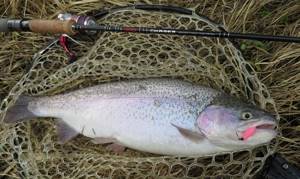
From the first ten days of October until freeze-up, the most significant surge in bite is observed. Fishing is carried out using float, spinning and bottom gear. Winter is a relatively weak season for fishing. The fish does not feed during the mating season, and after it saves energy by hiding in the recesses of the bottom, only occasionally picking up passing food nearby. But knowing the anchorage points of a school of fish, fish can be successfully caught from the ice and taken for bets. With the appearance of melt water and the disappearance of ice, spring activates the predator for increased feeding and until the water temperature stabilizes at levels above 15 degrees, the fish bite greedily and with equal constancy. In muddy water they fish with spinning rods and float rigs. In summer, fish are caught near cool springs and shady shores of the reservoir. The bite is unstable, improving only when it gets colder.
Important! Characterizing the intensity of the bite according to the daily cycle, it is worth noting that in any period of the year, early morning and evening twilight stand out most from the rest of the time in terms of frequent attacks by the predator.
During the day, the bite is active only in late autumn and on some winter days, with a slight thaw. Cloudy weather with light drizzle is ideal for fishing. The sun always negatively affects the activity of cautious and timid fish.
Lures for fishing
The nutritional interests of salmon fish species vary in their preferences depending on the season of the year. During periods of mass emergence of insects from spring to the first half of autumn, the fish actively feeds on any type of mayfly. The rest of the time, the predator hunts for small fish and waterfowl, and also collects plankton of various compositions from freshwater crustaceans and larvae of various insects at the bottom.

On platoons, trout are accustomed to eating food of plant origin based on fish feed and flour ingredients, and in particular, ordinary white and black bread. Like natural food of animal origin, due to the aggressive nature of the predator, it is caught using various imitations of natural food objects, equipping them with hooks. Next, we will take a closer look at baits for catching this type of fish, dividing it into natural and artificial baits.
Natural baits
Natural baits include leaf and dung worms, using them in baits mixed with maggots, verkhovka fry, gudgeon, bleak. To inert baits, due to the high success of their use, you can safely add fillets of various types of fish, the pulp of toothless clams and pearl barley, crumbs of white and black bread, as well as flavored dough, which was transformed by modernizing the composition and improving the balance of ingredients into a specialized bait, the so-called trout paste.
Artificial baits
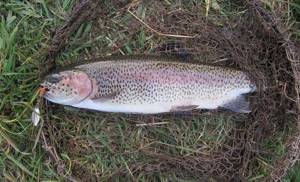
Spinning rods for trout fishing are equipped with wobblers such as minnow and crank, rarely exceeding five centimeters in size. It is preferable to select a minnow with its own game, which makes the animation of the bait on a regular uniform reeling. Rotating spinners with petals in the form of a drop and a willow leaf, with striped colors or with distinct red or blue dots scattered over the area of the working body are also enjoying significant success. Artificial flies and beetles with non-wetting hair feathers attract predators no less than dense and voluminous baits.
Which spinning rod to choose for trout fishing - an overview of the main characteristics
Content
Beginning fishing enthusiasts are faced with the problem of choosing a spinning rod model for trout hunting. After all, fishing stores offer various types of fishing rods, and without the advice of professionals, it is problematic to choose a spinning rod. And although sales consultants will be happy to tell you which spinning rod is suitable for fishing, it is important to figure out this issue yourself. Each fishing enthusiast is guided by his own evaluation criteria.
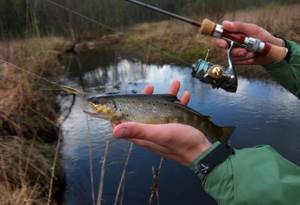
Fishing success depends on choosing the right spinning rod
Beginning spinners believe that a spinning rod should have the following characteristics:
- reliability;
- ease;
- versatility.
It's hard to argue with this. However, professional fishermen focus primarily on the structure of the spinning rod. This characteristic reflects the ability of a spinning rod to respond to fluctuations in load.
The system determines:
- possible wiring options and smoothness;
- accuracy of the cast;
- the distance to which the leash with bait is thrown;
- spinning whip sensitivity;
- the ability of the rod to smooth out jerks when fishing.
When choosing spinning rods for catching pond trout or river fish, pay attention to the bending of the spinning rod under load.
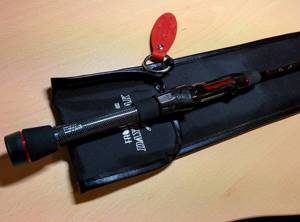
First of all, professional fishermen focus on the spinning system.
According to this criterion, spinning rods are classified as follows:
- Extra Fast (accelerated) – when loaded, 1/4 of the length of the whip, located in the upper part of the rod, bends radially. This design nuance guarantees increased casting accuracy and minimal smoothness when playing with the bait;
- Fast (fast) – when casting and retrieving fish, 1/3 of the length of the tackle is deformed. As a result, the retrieve is smoother, the shock-absorbing characteristics when retrieving fish are increased, but the hooking speed is reduced;
- Medium – in the process of retrieving and retrieving the catch, the upper half of the spinning rod bends. Such a rod intensively smoothes out the jerks of strong fish when playing, but is inferior in sensitivity and accuracy;
- Slow – the rod bends evenly along the length of the whip, acquiring a parabolic configuration. Thanks to its uniform bending, the whip quickly returns to its original state, providing increased casting distance and increased smoothness when retrieved.
Read more
What is casting spinning rod and how to choose the right one?
Along with the rigidity of the rod, you need to pay attention to the following points:
- permissible weight of the bait being thrown;
- number of sections and length of the spinning whip;
- material used to make the handle;
- spinning sensors;
- reliability of fastening of the reel seat and guide rings.
After analyzing the rating of spinning rods for trout fishing, choose light or ultra-light class rods that have a fast action. These types of rods work well with light bait, which is used when landing trout. Also pay attention to the material from which the whip is made. The best spinning rods for trout fishing are made on the basis of carbon fiber, which provides the required plasticity and improved response during the retrieving process, as well as when pulling in resisting prey.
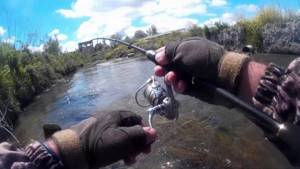
The best spinning rods for trout fishing are made from carbon fiber.
When choosing a spinning rod, consider the location of your upcoming fishing:
- It is advisable to use a short spinning rod on an overgrown bank;
- To lure them out of holes in open reservoirs, you will need an extended spinning rod.
Spinning rods of domestic and foreign production are used for trout fishing. The models have the following characteristics:
- whip length in the range from 170 to 300 cm;
- rod test ranging from 1 to 10 grams;
- tuning Fast (fast) or Medium (medium).
A properly selected spinning rod can cast a light bait far and accurately and, after biting, confidently reel in a strong and wary fish.
Choosing a trout spinning rod
Spinning rods for trout differ in their technical characteristics depending on the type of reservoir in which fishing is carried out. The natural conditions of a reservoir with rapid currents require more stringent conditions for the parameters of gear, in contrast to comfortable fishing on paid ponds with stagnant water. Let's consider the main approaches to choosing gear based on these differences in the structure of the reservoir.
Length selection

In a pay zone, the length of the gear is selected taking into account the possibilities of fishing from the shore or fishing from a boat. If casts are made from clean banks or a bridge, then a length of three meters is quite enough for easy fishing. From a boat, use gear no longer than 2.1–2.5 meters. Such tools allow casting with a more accurate supply of bait and not restricting the already limited space of the craft. On fast-moving streams, they fish in a wade, getting closer to promising fish sites, therefore, they use shorter tackle, ranging from 1.8-2.3 meters.
Important! Plug-in versions of fishing rods are preferable to telescopic ones, due to greater tactile sensitivity and reliability of the structure.
Scale selection
Slow and soft gear is used on pay fishing grounds, since the absence of currents gives a clear vision of the bite, and the slow action helps to catch fish efficiently on thin lines, without fear of their breaking. In conditions of strong currents, streaming versions of spinning rods with a rigid, ultra-fast action are used. This quality allows even with the slightest touch of the fish to the bait to detect it.
Test selection
Due to the use of light baits, they are caught using ultra-light versions of gear with tests no higher than 5 grams. In particularly strong currents, it is wise to use light spinning rods with weights up to 15 grams, which allows you to better deal with current resistance using weighted baits.
Coil selection
An important criterion for the reel is its light weight and the presence of a finely adjustable clutch. The elegance of the tackle depends on the balance of the rod and reel in their masses.
Important! The reel should have a high gear ratio; this is an important parameter when performing fast retrieving with the least amount of activity from the angler, which, even in minimal quantities, definitely alerts the fish.
Line selection
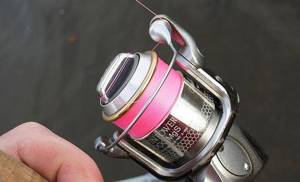
As the main cord, it is rational to use thin braided fishing lines in the color of water. But it is better to use monofilament or fluorocarbon as a driving material at the mounting tip. A meter cut is enough for quality fishing. The transparency of the line increases the fish's ability to attack, and the stretchability of the material perfectly compensates for overloads when fighting to catch a caught trophy.
Trout float rod equipment
Fishing for trout with a float does not differ much in terms of installation from most methods of forming equipment for catching peaceful fish. The assembly algorithm consists of selecting a fishing line on which a float balanced by weights, a leash and a hook are attached. The auxiliary accessories for the trout float mounting kit will require swivels, silicone stoppers and quick-release carabiners.
Important! Since trout are quite timid and suspicious, rough equipment definitely does not bring positive fishing results, often simply scaring away the trophy. All components of the installation must be harmonious with each other in size and not stand out with the brightness of the colors.
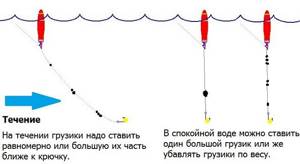
If possible, equipment should have as few elements and connecting nodes as possible.
Coil
In Bolognese and match fishing rods, the equipment includes reels. Inertialess ones are more popular for assembling gear. They are easier to manipulate when casting and landing fish, they are unpretentious in maintenance and hold a large amount of fishing line, ensuring even the longest casts without worrying about the supply necessary for these purposes. For both matcha and lapdogs, small-sized mechanisms of 1500-2500 units are selected with only a friction clutch, without unnecessary functions.
For the sake of objectivity, it is worth noting that there is an opinion that claims that it is more comfortable to catch trout with a fishing rod equipped with an inertia rod. There is some truth in this, since these types of reels are much lighter than the meat grinders familiar to most anglers. But perfect mastery of the casting technique and the lack of a thin clutch mechanism are serious obstacles to their widespread use in trout fishing by ordinary, and even more so, novice fishermen.
fishing line
Since hunting is carried out at medium and short distances, catching trout with a float rod is ensured by using monofilament fishing line as the main cord. In addition, the monofilament is transparent and does not arouse suspicion in the fish, and its high stretch coefficient quite successfully helps to cope with the sometimes fierce resistance of the trophy that takes the bait. Flying and Bolognese fishing rods are equipped with a fishing line of 0.20-0.25 mm. For matcha, a cord with a diameter of 0.25-0.30 mm is used. The installation must include leashes made of 0.15-0.18 mm nylon lines or fluorocarbon versions of the element with a breaking load an order of magnitude lower than that of the main cord.
Hooks
When selecting a hook for a float mount, they are guided by the type of bait used in fishing. Often the range of an effective and practical piece of equipment falls within the range of 6-10 accessory numbers. When planning to catch large specimens of predators, the use of larger hooks of numbers 3-5 is justified. If fluid baits, trout pastes or dough are used as bait, then hooks with springs are installed in the rigs, which reliably and for a long time hold the bait in the water and during casting. Otherwise, the hooks should have natural color tones, gray or dark blue, and, of course, a sharp point.
Often, at the beginning of fishing, the fishing technique with two hooks is justified. The method allows you to much faster determine the horizon of active fish and, after reconnaissance, switch to the classic type of equipment with one hook. An additional leash can be made longer or shorter than the main one, as well as equipped with different types of bait and thus find the most promising fishing option, increasing the chances of ultimate success.
Floats

The practice of trout fishing shows that drop-shaped, oval or spherical floats are the most effective for fishing. The lower part of the alarm, submerged in water, is painted in non-garish natural tones, but the float antenna, on the contrary, should clearly stand out with its colors on the surface of the reservoir. Fishing on paid platforms has more comfortable conditions, which is why the mass of floats rarely exceeds 10 grams.
Basically, fishing is carried out using signaling devices in the range of 1.5-4 grams. For matcha, sliding types of floats are used; for bologna and swing, it is more practical to use floats with a blind fastening method. In fishing stores you can find floats specialized for trout fishing, the designs of which, with factory settings, take into account the nuances and characteristics of trout biting.
How to catch trout using a spinning rod
Let's consider the technique of spinning fishing on artificial paid ponds and streams and rivers of natural origin. Significant differences in the structure of reservoirs force the use of different hunting strategies and tactics, the nuances of which must be taken into account by the spinning angler.
Fishing for trout on a platform
On paid sites, it is recommended to initially find out the places where the fish are most likely to stop and start fishing from these points. Trout spinners are always a priority in such ponds. Having presented the bait five to seven meters from a promising point, it is laid on the bottom. Next, with a sharp detonation, the petal is cocked and carried out along the selected trajectory at an increased speed. The bite is felt by a sharp blow and a quick movement of the cord to the side. To this action, the fisherman responds by hooking and begins to land the hooked fish. Fishing is always stormy, with candles and persistent struggle on the part of the trophy. The spinner should try to keep the line taut, managing to make timely reels and not giving the fish the opportunity to spit out the bait. Near the shore, the fish are taken into a landing net. If there are no bites after five casts, change the location.
Fishing for trout in streams
Under natural conditions, wobblers for trout are more catchy than other baits. The bait is supplied to the fishing zone, moving along the current, as the fish faces the stream, waiting for food floating towards it. They catch them in a wade, thus masking their location. Spinning fishing for trout in the fall can also be done from the shore, since during the feeding season the fish are less cautious. The wobbler is released into the stream of jets, promptly removing the slack of the cord. The spinner moves through promising places to meet the current, making ten or twelve moves at stopping points. The caught fish is brought to a quiet shallows and raised to the surface with a net.
Source: IaRybak.ru
Bottom tackle for trout
